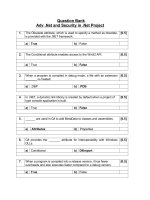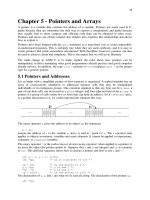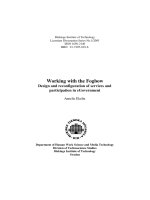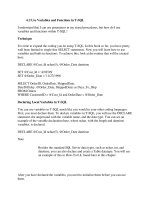Friends, Overloaded Operators, and Arrays in Classes
Bạn đang xem bản rút gọn của tài liệu. Xem và tải ngay bản đầy đủ của tài liệu tại đây (3.83 MB, 127 trang )
Copyright © 2007 Pearson Education, Inc. Publishing as Pearson Addison-Wesley
Chapter 11
Friends, Overloaded Operators,
and Arrays in Classes
Slide 11- 3
Copyright © 2007 Pearson Education, Inc. Publishing as Pearson Addison-Wesley
Overview
11.1 Friend Functions
11.2 Overloading Operators
11.3 Arrays and Classes
11.4 Classes and Dynamic Arrays
Copyright © 2007 Pearson Education, Inc. Publishing as Pearson Addison-Wesley
11.1
Friend Functions
Slide 11- 5
Copyright © 2007 Pearson Education, Inc. Publishing as Pearson Addison-Wesley
Friend Function
Class operations are typically implemented
as member functions
Some operations are better implemented as
ordinary (nonmember) functions
Slide 11- 6
Copyright © 2007 Pearson Education, Inc. Publishing as Pearson Addison-Wesley
Program Example:
An Equality Function
The DayOfYear class from Chapter 6 can
be enhanced to include an equality function
An equality function tests two objects of
type DayOfYear to see if their values represent
the same date
Two dates are equal if they represent the same
day and month
Slide 11- 7
Copyright © 2007 Pearson Education, Inc. Publishing as Pearson Addison-Wesley
Declaration of
The equality Function
We want the equality function to return a value
of type bool that is true if the dates are the same
The equality function requires a parameter for
each of the two dates to compare
The declaration is
bool equal(DayOfYear date1, DayOfYear date2);
Notice that equal is not a member of the class
DayOfYear
Slide 11- 8
Copyright © 2007 Pearson Education, Inc. Publishing as Pearson Addison-Wesley
Defining Function equal
The function equal, is not a member function
It must use public accessor functions to obtain the
day and month from a DayOfYear object
equal can be defined in this way:
bool equal(DayOfYear date1, DayOfYear date2)
{
return ( date1.get_month( ) == date2.get_month( )
&&
date1.get_day( ) == date2.get_day( ) );
}
Slide 11- 9
Copyright © 2007 Pearson Education, Inc. Publishing as Pearson Addison-Wesley
Display 11.1 (1)
Display 11.1 (2)
Display 11.1 (3)
Using The Function equal
The equal function can be used to compare dates
in this manner
if ( equal( today, bach_birthday) )
cout << "It's Bach's birthday!";
A complete program using function equal is
found in
Slide 11- 10
Copyright © 2007 Pearson Education, Inc. Publishing as Pearson Addison-Wesley
Is equal Efficient?
Function equal could be made more efficient
Equal uses member function calls to obtain the
private data values
Direct access of the member variables would
be more efficient (faster)
Slide 11- 11
Copyright © 2007 Pearson Education, Inc. Publishing as Pearson Addison-Wesley
A More Efficient equal
As defined here, equal is more efficient,
but not legal
bool equal(DayOfYear date1, DayOfYear date2)
{
return (date1.month = = date2.month
&&
date1.day = = date2.day );
}
The code is simpler and more efficient
Direct access of private member variables is not legal!
Slide 11- 12
Copyright © 2007 Pearson Education, Inc. Publishing as Pearson Addison-Wesley
Friend Functions
Friend functions are not members of a class, but
can access private member variables of the class
A friend function is declared using the keyword
friend in the class definition
A friend function is not a member function
A friend function is an ordinary function
A friend function has extraordinary access to data
members of the class
As a friend function, the more efficient version
of equal is legal
Slide 11- 13
Copyright © 2007 Pearson Education, Inc. Publishing as Pearson Addison-Wesley
Declaring A Friend
The function equal is declared a friend in the
abbreviated class definition here
class DayOfYear
{
public:
friend bool equal(DayOfYear date1,
DayOfYear date2);
// The rest of the public members
private:
// the private members
};
Slide 11- 14
Copyright © 2007 Pearson Education, Inc. Publishing as Pearson Addison-Wesley
Display 11.2
Using A Friend Function
A friend function is declared as a friend in the
class definition
A friend function is defined as a nonmember
function without using the "::" operator
A friend function is called without using the
'.' operator
Slide 11- 15
Copyright © 2007 Pearson Education, Inc. Publishing as Pearson Addison-Wesley
Friend Declaration Syntax
The syntax for declaring friend function is
class class_name
{
public:
friend Declaration_for_Friend_Function_1
friend Declaration_for_Friend_Function_2
…
Member_Function_Declarations
private:
Private_Member_Declarations
};
Slide 11- 16
Copyright © 2007 Pearson Education, Inc. Publishing as Pearson Addison-Wesley
Are Friends Needed?
Friend functions can be written as non-friend
functions using the normal accessor and mutator
functions that should be part of the class
The code of a friend function is simpler and it is
more efficient
Slide 11- 17
Copyright © 2007 Pearson Education, Inc. Publishing as Pearson Addison-Wesley
Choosing Friends
How do you know when a function should be
a friend or a member function?
In general, use a member function if the task
performed by the function involves only one object
In general, use a nonmember function if the task
performed by the function involves more than
one object
Choosing to make the nonmember function a friend is
a decision of efficiency and personal taste
Slide 11- 18
Copyright © 2007 Pearson Education, Inc. Publishing as Pearson Addison-Wesley
Display 11.3 (1 – 5)
Program Example:
The Money Class (version 1)
Display 11.3 demonstrates a class called Money
U.S. currency is represented
Value is implemented as an integer
representing the value as if converted to
pennies
An integer allows exact representation of the value
Type long is used to allow larger values
Two friend functions, equal and add, are used
Slide 11- 19
Copyright © 2007 Pearson Education, Inc. Publishing as Pearson Addison-Wesley
Characters to Integers
Notice how function input (Display 11.3)
processes the dollar values entered
First read the character that is a $ or a –
If it is the -, set the value of negative to true and read the
$ sign which should be next
Next read the dollar amount as a long
Next read the decimal point and cents as three
characters
digit_to_int is then used to convert the cents characters to
integers
Slide 11- 20
Copyright © 2007 Pearson Education, Inc. Publishing as Pearson Addison-Wesley
digit_to_int (optional)
digit_to_int is defined as
int digit_to_int(char c)
{
return ( int ( c ) – int ( '0') );
}
A digit, such as '3' is parameter c
This is the character '3' not the number 3
The type cast int(c) returns the number that implements
the character stored in c
The type cast int('0') returns the number that implements
the character '0'
Slide 11- 21
Copyright © 2007 Pearson Education, Inc. Publishing as Pearson Addison-Wesley
int( c) – int ('0')?
The numbers implementing the digits are in
in order
int('0') + 1 is equivalent to int('1')
int('1') + 1 is equivalent to int('2')
If c is '0'
int( c ) - int('0') returns integer 0
If c is '1'
int( c ) – int ('0') returns integer 1
Slide 11- 22
Copyright © 2007 Pearson Education, Inc. Publishing as Pearson Addison-Wesley
Leading Zeros
Some compilers interpret a number with a
leading zero as a base 8 number
Base 8 uses digits 0 – 7
Using 09 to represent 9 cents could cause an error
the digit 9 is not allowed in a base 8 number
The ANSI C++ standard is that input should be interpreted
as base 10 regardless of a leading zero
Slide 11- 23
Copyright © 2007 Pearson Education, Inc. Publishing as Pearson Addison-Wesley
Parameter Passing Efficiency
A call-by-value parameter less efficient than a
call-by-reference parameter
The parameter is a local variable initialized to the
value of the argument
This results in two copies of the argument
A call-by-reference parameter is more efficient
The parameter is a placeholder replaced by the
argument
There is only one copy of the argument
Slide 11- 24
Copyright © 2007 Pearson Education, Inc. Publishing as Pearson Addison-Wesley
Class Parameters
It can be much more efficient to use
call-by-reference parameters when the parameter
is of a class type
When using a call-by-reference parameter
If the function does not change the value of the
parameter, mark the parameter so the compiler
knows it should not be changed
Slide 11- 25
Copyright © 2007 Pearson Education, Inc. Publishing as Pearson Addison-Wesley
const Parameter Modifier
To mark a call-by-reference parameter so it
cannot be changed:
Use the modifier const before the parameter
type
The parameter becomes a constant parameter
const used in the function declaration and
definition









